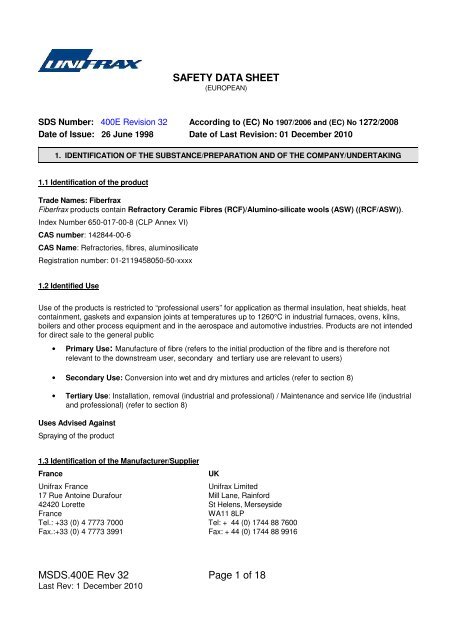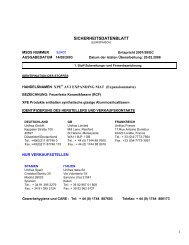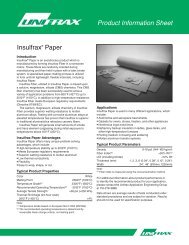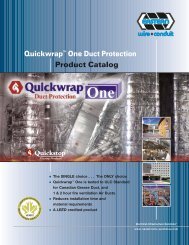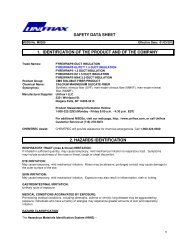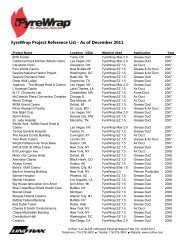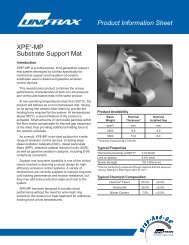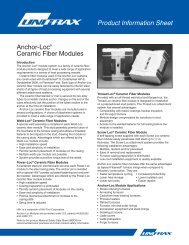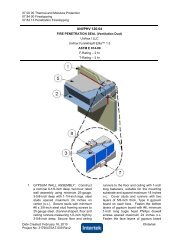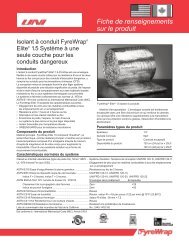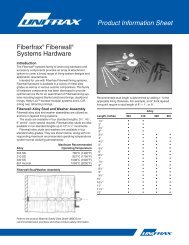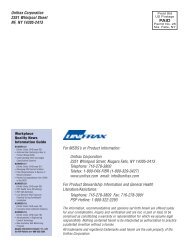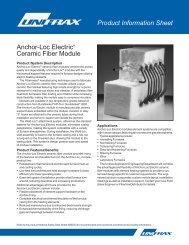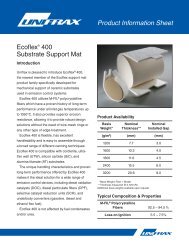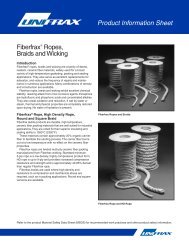MSDS.400E Rev 32 Page 1 of 18 SAFETY DATA SHEET - Unifrax
MSDS.400E Rev 32 Page 1 of 18 SAFETY DATA SHEET - Unifrax
MSDS.400E Rev 32 Page 1 of 18 SAFETY DATA SHEET - Unifrax
You also want an ePaper? Increase the reach of your titles
YUMPU automatically turns print PDFs into web optimized ePapers that Google loves.
<strong>SAFETY</strong> <strong>DATA</strong> <strong>SHEET</strong><br />
(EUROPEAN)<br />
SDS Number: 400E <strong>Rev</strong>ision <strong>32</strong> According to (EC) No 1907/2006 and (EC) No 1272/2008<br />
Date <strong>of</strong> Issue: 26 June 1998 Date <strong>of</strong> Last <strong>Rev</strong>ision: 01 December 2010<br />
1. IDENTIFICATION OF THE SUBSTANCE/PREPARATION AND OF THE COMPANY/UNDERTAKING<br />
1.1 Identification <strong>of</strong> the product<br />
Trade Names: Fiberfrax<br />
Fiberfrax products contain Refractory Ceramic Fibres (RCF)/Alumino-silicate wools (ASW) ((RCF/ASW)).<br />
Index Number 650-017-00-8 (CLP Annex VI)<br />
CAS number: 142844-00-6<br />
CAS Name: Refractories, fibres, aluminosilicate<br />
Registration number: 01-2119458050-50-xxxx<br />
1.2 Identified Use<br />
Use <strong>of</strong> the products is restricted to “pr<strong>of</strong>essional users” for application as thermal insulation, heat shields, heat<br />
containment, gaskets and expansion joints at temperatures up to 1260°C in industrial furnaces, ovens, kilns,<br />
boilers and other process equipment and in the aerospace and automotive industries. Products are not intended<br />
for direct sale to the general public<br />
• Primary Use: Manufacture <strong>of</strong> fibre (refers to the initial production <strong>of</strong> the fibre and is therefore not<br />
relevant to the downstream user, secondary and tertiary use are relevant to users)<br />
• Secondary Use: Conversion into wet and dry mixtures and articles (refer to section 8)<br />
• Tertiary Use: Installation, removal (industrial and pr<strong>of</strong>essional) / Maintenance and service life (industrial<br />
and pr<strong>of</strong>essional) (refer to section 8)<br />
Uses Advised Against<br />
Spraying <strong>of</strong> the product<br />
1.3 Identification <strong>of</strong> the Manufacturer/Supplier<br />
France UK<br />
<strong>Unifrax</strong> France <strong>Unifrax</strong> Limited<br />
17 Rue Antoine Durafour Mill Lane, Rainford<br />
42420 Lorette St Helens, Merseyside<br />
France WA11 8LP<br />
Tel.: +33 (0) 4 7773 7000 Tel: + 44 (0) 1744 88 7600<br />
Fax.:+33 (0) 4 7773 3991 Fax: + 44 (0) 1744 88 9916<br />
<strong>MSDS.400E</strong> <strong>Rev</strong> <strong>32</strong> <strong>Page</strong> 1 <strong>of</strong> <strong>18</strong><br />
Last <strong>Rev</strong>: 1 December 2010
Germany<br />
<strong>Unifrax</strong> GmbH <strong>Unifrax</strong> GmbH<br />
Kleinreinsdorf 62 Postfach 16 01 62<br />
07989 Teichwolframsdorf 40564 Düsseldorf<br />
Tel: + 49 (0) 366 24 40020 Tel: +49 (0) 211 87746 0<br />
Fax: + 49 (0) 366 24 40099 Fax: +49 (0) 211 87746 115<br />
Czech Republic<br />
<strong>Unifrax</strong> s.r.o.<br />
Novosedicka 125<br />
417 03<br />
Dubi 3, Czech Republic<br />
Tel: + 42 (0) 417 800 356<br />
Fax: + 42 (0) 417 539 838<br />
SALES CONTACTS ONLY<br />
SPAIN ITALY<br />
<strong>Unifrax</strong> Spain <strong>Unifrax</strong> Italia Srl<br />
Cristobal Bordiu 20 Via Volonterio 19<br />
Madrid 28003 Saronno (Va) 21047<br />
Spain Italy<br />
Tel: + 34 91 395 2279 Tel: + 39 02 967 01 808<br />
Fax: + 34 91 395 2124 Fax: + 39 02 962 5721<br />
1.4 Emergency contact number<br />
Occupational Hygiene and CARE: Tel: + 44 (0) 1744 887603. Fax: + 44 (0) 1744 886173<br />
E Mail: reachsds@unifrax.co.uk<br />
Language: English<br />
Opening hours: Only available during <strong>of</strong>fice hours<br />
2.1 Classification <strong>of</strong> the substance/mixture<br />
2. HAZARDS IDENTIFICATION<br />
2.1.1 Classification according to Regulation (EC) No 1272/2008<br />
Under the CLP-Regulation (classification, labelling and packaging <strong>of</strong> substances and mixtures) RCF/ASW has<br />
been classified as a 1B carcinogen (“presumed to have carcinogenic potential for humans, classification is<br />
largely based on animal evidence”).<br />
2.1.2 Classification according to directive 67/548/EEC<br />
RCF/ASW have been classified as a category 2 carcinogen (“substances which should be regarded as if they<br />
are carcinogenic to man”)<br />
2.1.3 Additional information:<br />
The International Agency for Research on Cancer (IARC) reaffirmed that group 2B (“possibly carcinogenic to<br />
humans”) remains the appropriate classification for RCF/ASW.<br />
In accordance with 31 st<br />
Adaptation to Technical Progress (ATP) <strong>of</strong> Directive 67/548/ECC as published 15 th<br />
January 2009 the classification as “irritant” has been removed for all types <strong>of</strong> man made vitreous fibres<br />
(MMVFs).<br />
<strong>MSDS.400E</strong> <strong>Rev</strong> <strong>32</strong> <strong>Page</strong> 2 <strong>of</strong> <strong>18</strong><br />
Last <strong>Rev</strong>: 1 December 2010
The 1 st Adaptation to Technical Progress (ATP) to Regulation (EC) No 1272/2008 entered into force on 25<br />
September 2009. It transfers the 30 th and 31 st ATPs <strong>of</strong> Directive 67/548/EEC to the Regulation (EC) No<br />
1272/2008.<br />
2.2 Labelling elements<br />
Signal Word<br />
Danger<br />
Component Classification Hazard pictogram<br />
& Symbol<br />
Refractory ceramic fibres<br />
(Alumino-silicate wools)<br />
Hazard Statements<br />
May cause cancer by inhalation (H350i)<br />
(EC) No. 1272/2008<br />
<strong>MSDS.400E</strong> <strong>Rev</strong> <strong>32</strong> <strong>Page</strong> 3 <strong>of</strong> <strong>18</strong><br />
Last <strong>Rev</strong>: 1 December 2010<br />
GHS 08<br />
R Phrase<br />
& H Statement<br />
H350i<br />
Directive 67/548/EEC T R49<br />
Precautionary statements<br />
Do not handle until all safety instructions have been read and understood. (P202)<br />
Use personal protective equipment as required. (P281)<br />
2.3 Other hazards which do not result in classification:<br />
Mild mechanical irritation to skin, eyes and upper respiratory system may result from exposure.<br />
These effects are usually temporary<br />
3.1 Composition<br />
3. COMPOSITION / INFORMATION OF INGREDIENTS<br />
Chemical composition <strong>of</strong> Refractory Ceramic Fibres (RCF/ASW): SiO2 45-60% - Al2O3 40-55%<br />
None <strong>of</strong> the components are radioactive under the terms <strong>of</strong> European Directive Euratom 96/29<br />
3.2 Description<br />
COMPONENT CAS NUMBER<br />
Refractory ceramic<br />
fibres (Aluminosilicate<br />
wools)<br />
Index number in<br />
CLP Annex VI<br />
% by weight<br />
142 844 –00 -6 650-017-00-8 100<br />
Fiberfrax products are available in a variety <strong>of</strong> forms: bulks, blankets, papers, felts, boards, shapes, modules,<br />
cements, textiles (braids, ropes, and cloth), coatings, mixes, mastics. (Reference: BS EN 1094-1:1997)
Skin<br />
4. FIRST AID MEASURES<br />
In case <strong>of</strong> skin irritation rinse affected areas with water and wash gently. Do not rub or scratch exposed skin.<br />
Eyes<br />
In case <strong>of</strong> eye contact flush abundantly with water; have eye bath available. Do not rub eyes.<br />
Nose and Throat:<br />
If nose or throat becomes irritated move to a dust free area, drink water and blow nose.<br />
If symptoms persist, seek medical advice.<br />
5. FIRE-FIGHTING MEASURES<br />
Non combustible products. Packaging and surrounding materials may be combustible. Class <strong>of</strong> reaction to fire is<br />
zero.<br />
Use extinguishing agent suitable for surrounding combustible materials<br />
6. ACCIDENTAL RELEASE MEASURES<br />
6.1 Personal precautions, protective equipment and emergency procedures<br />
Where abnormally high dust concentrations occur, provide workers with appropriate protective equipment as<br />
detailed in section 8.<br />
Restrict access to the area to a minimum number <strong>of</strong> workers required.<br />
Restore the situation to normal as quickly as possible.<br />
6.2 Environmental precautions<br />
Prevent further dust dispersion for example by dampening the materials<br />
Do not flush spillage to drain.<br />
Check for local regulations, which may apply.<br />
6.3 Methods and materials for containment and clean up<br />
Pick up large pieces and use a vacuum cleaner fitted with a high efficiency filter (HEPA)<br />
If brushing is used, ensure that the area is wetted down first.<br />
Do not use compressed air for clean up.<br />
Do not allow to be wind blown.<br />
7.1 Precautions for safe handling<br />
7. HANDLING AND STORAGE<br />
Handling can be a source <strong>of</strong> dust emission and therefore the processes should be designed to limit the amount<br />
<strong>of</strong> handling. Whenever possible, handling should be carried out under controlled conditions (i.e., using dust<br />
exhaust system).<br />
Regular good housekeeping will minimise secondary dust dispersal.<br />
<strong>MSDS.400E</strong> <strong>Rev</strong> <strong>32</strong> <strong>Page</strong> 4 <strong>of</strong> <strong>18</strong><br />
Last <strong>Rev</strong>: 1 December 2010
7.2 Conditions for safe storage<br />
Store in original packaging in dry area whilst awaiting use.<br />
Always use sealed and visibly labelled containers.<br />
Avoid damaging containers.<br />
Reduce dust emission during unpacking.<br />
Emptied containers, which may contain debris, should be cleaned (see 6.3) before disposal or recycling.<br />
Recyclable cardboard and/or plastic films are recommended for packaging.<br />
7.3 Specific end use<br />
The main application <strong>of</strong> these products is as thermal insulation. Use <strong>of</strong> the products is restricted to “pr<strong>of</strong>essional<br />
users”. Please refer to section 8 and the relevant exposure scenario.<br />
8. RISK MANAGEMENT MEASURES/EXPOSURE CONTROL / PERSONAL PROTECTION<br />
8.1 Control Parameters<br />
Industrial hygiene standards and occupational exposure limits vary between countries and local jurisdictions.<br />
Check which exposure levels apply to your facility and comply with local regulations. If no regulatory dust or<br />
other standards apply, a qualified industrial hygienist can assist with a specific workplace evaluation including<br />
recommendations for respiratory protection.<br />
8.1.1 National Limit Values<br />
Examples <strong>of</strong> national OELs (December 2010) are given in the table below. Additional references and/or updates<br />
can be found on the following websites:<br />
http://www.dguv.de/ifa/en/gestis/limit_values<br />
http://osha.europa.eu/en/publications/reports/548OELs/view<br />
COUNTRY OEL*<br />
Austria 0.5 f/ml<br />
Belgium 0.5 f/ml<br />
Czech Republic 1.0 f/ml<br />
Denmark 1.0 f/ml<br />
Finland 0.2 f/ml<br />
France*** 0.1 f/ml<br />
Germany*** 0.2 f/ml (max. tolerance-concentration)**<br />
Italy 0.2 f/ml<br />
Poland 0.5 f/ml<br />
Spain 0.5 f/ml<br />
Sweden 0.2 f/ml<br />
The Netherlands 0.5 f/ml<br />
UK*** 1.0 f/ml<br />
Note:<br />
* 8-hr time weighted average concentrations <strong>of</strong> airborne respirable fibres measured using the conventional<br />
membrane filter method<br />
** In Germany, OELs were replaced by concentration ranges following a risk based concept. The maximum<br />
“tolerance-concentration” is 0.2 f/ml following TRGS 558 in combination with BekGS 910.<br />
*** Source <strong>of</strong> OEL is detailed in section 15<br />
<strong>MSDS.400E</strong> <strong>Rev</strong> <strong>32</strong> <strong>Page</strong> 5 <strong>of</strong> <strong>18</strong><br />
Last <strong>Rev</strong>: 1 December 2010
The Scientific Committee on Occupational Exposure Limit Values (SCOEL) as set up by a Commission<br />
Decision (95/<strong>32</strong>0/EC) have proposed an OEL for RCF/ASW <strong>of</strong> 0.3 f/ml.<br />
8.1.2 Recommended monitoring programmes<br />
France has a monitoring programme in line with test method reference number XP X43-269 dated March 2002,<br />
which is used to check for compliance with the OEL <strong>of</strong> 0.1 f/ml.<br />
The UK follow MDHS 59 specific for MMVF: “Man-made mineral fibre - Airborne number concentration by<br />
phase-contrast light microscopy” and MDHS 14/3 “General methods for sampling and gravimetric analysis <strong>of</strong><br />
respirable and inhalable dust”<br />
Germany recommends following the rules as laid out in TRGS 402 and describes applicable sampling /<br />
analytical methods in BGI 505-31 and BGI 505-46.<br />
WHO-EURO method: Determination <strong>of</strong> airborne fibre number concentrations; A recommended method, by<br />
phase-contrast optical microscopy (membrane filter method); World Health Organisation Geneva 1997 ISBN 92<br />
4 154496 1.<br />
8.1.3 DNEL/DMEL<br />
The calculation <strong>of</strong> DMELs for fibres alone is not possible; a precautionary value is assigned based on fibrosis.<br />
An inhalation DMEL <strong>of</strong> 0.5 mg/m3 with an assessment factor <strong>of</strong> 25 can be calculated based on repeated dose<br />
toxicity, this value in the correct units would give a DMEL <strong>of</strong> 4 f/ml.<br />
8.2 Exposure Controls<br />
8.2.1 Appropriate engineering controls<br />
<strong>Rev</strong>iew your application(s) and assess situations with the potential for dust release.<br />
Where practical, enclose dust sources and provide dust extraction at source.<br />
Designate work areas and restrict access to informed and trained workers.<br />
Use operating procedures that will limit dust production and exposure <strong>of</strong> workers.<br />
Keep the workplace clean. Use a vacuum cleaner fitted with a HEPA filter; avoid using brooms and compressed<br />
air.<br />
If necessary, consult an industrial hygienist to design workplace controls and practices.<br />
The use <strong>of</strong> products specially tailored to your application(s) will help to control dust. Some products can be<br />
delivered ready for use to avoid further cutting or machining. Some could be pre-treated or packaged to<br />
minimise or avoid dust release during handling.<br />
Consult your supplier for further details<br />
<strong>MSDS.400E</strong> <strong>Rev</strong> <strong>32</strong> <strong>Page</strong> 6 <strong>of</strong> <strong>18</strong><br />
Last <strong>Rev</strong>: 1 December 2010
Table <strong>of</strong> Uses and Risk Management Measures (RMM):<br />
Intended use RMM - Hierarchy <strong>of</strong> Controls<br />
Secondary use – Conversion<br />
into wet and dry mixtures and<br />
articles.<br />
Process would include: Mixing<br />
forming operations, handling<br />
<strong>of</strong> RCF/ASW products,<br />
assembly <strong>of</strong> RCF/ASW<br />
containing products, machine<br />
and hand finishing <strong>of</strong><br />
RCF/ASW products.<br />
Reference ES 2*<br />
Intended use RMM - Hierarchy <strong>of</strong> Controls<br />
Tertiary use - maintenance<br />
and service life (Industrial or<br />
pr<strong>of</strong>essional use)<br />
Process: Small scale repairs<br />
involving removal and<br />
installation <strong>of</strong> RCF/ASW<br />
products. Use <strong>of</strong> the product in<br />
an enclosed system, where<br />
there is occasional control<br />
access or no access.<br />
Reference ES 3*<br />
Intended use RMM - Hierarchy <strong>of</strong> Controls<br />
Tertiary use- installation and<br />
removal (industrial or<br />
pr<strong>of</strong>essional).<br />
Large scale removal and<br />
installation <strong>of</strong> RCF/ASW from<br />
Industrial processes.<br />
Large scale removal and<br />
installation by pr<strong>of</strong>essionals.<br />
Reference ES 4*<br />
<strong>MSDS.400E</strong> <strong>Rev</strong> <strong>32</strong> <strong>Page</strong> 7 <strong>of</strong> <strong>18</strong><br />
Last <strong>Rev</strong>: 1 December 2010<br />
- Where it is practical to do so, automatically feed RCF/ASW in to the<br />
process<br />
- Where practical to do so, segregate dry and wet processing<br />
- Enclose the process where practically possible.<br />
- Where practical to do so, segregate machine areas and restrict<br />
access to operators involved in the process.<br />
- Enclose Machines as far as practically possible.<br />
- Install LEV where possible, when machine finishing, handling,<br />
compressing and hand cutting to remove dust at source<br />
- Employ experienced personnel – trained in the correct use <strong>of</strong><br />
fibrous products<br />
- PPE and RPE used for all dusty tasks<br />
- Provide vacuum cleaner connection point to central system where<br />
practical or use a portable HEPA vacuum<br />
- Regular clean up – using a wet scrubbing unit where practically<br />
possible and in general a HEPA vacuum should be used.<br />
- Dry brushing and use <strong>of</strong> compressed air should be prohibited<br />
- Waste materials to be contained at source, labelled and stored<br />
separately for disposal or recycling.<br />
- Use pre-cut, pre-sized pieces where practically possible.<br />
- Allow access only to trained (authorised ) operators<br />
- Where practically possible, perform all hand cutting in a segregated<br />
area, on a down draft bench.<br />
- Clean up work area regularly during the shift using a HEPA<br />
equipped vacuum cleaner.<br />
- Prohibit use <strong>of</strong> dry brushing and compressed air cleaning.<br />
- Bag and seal waste immediately at source.<br />
- Use PPE and RPE appropriate to task.<br />
- Employ good hygiene practices.<br />
- Where practically possible enclose or segregate the work area.<br />
- Allow only authorised personnel.<br />
- Pre-wet insulation prior to removal where practically possible.<br />
- Where practically possible use a water lance for removal or<br />
vacuum-truck.<br />
- Use down draft bench for hand cutting products.<br />
- Cover pre-cut section during transport and storage to prevent<br />
secondary exposure.<br />
- Where practically possible provide multiple vacuum hoses for<br />
convenient cleanup <strong>of</strong> spillage or use portable HEPA filtered<br />
vacuums.<br />
- Bag waste materials immediately at source<br />
- Prohibit use <strong>of</strong> dry brushing and or compressed air cleaning.<br />
- Experienced personnel only
- Use appropriate PPE and RPE appropriate to expected<br />
concentrations<br />
* Exposure Scenarios are available in full from your <strong>Unifrax</strong> supplier (ES2, ES3 and ES4)<br />
8.2.2 Personal Protective Equipment<br />
Skin Protection<br />
If working with virgin material, wear industrial leather gloves and work clothes, which are loose fitting at the neck<br />
and wrists. Soiled clothes should be cleaned to remove excess dust before being taken <strong>of</strong>f (e.g. use vacuum<br />
cleaner, not compressed air). Each worker should be provided with two lockers in an appropriate changing and<br />
washing area. It is good hygiene practice to ensure work clothes are washed separately by the employer. Work<br />
clothes should not be taken home.<br />
Eye Protection<br />
As necessary, wear goggles or safety glasses with side shields<br />
Respiratory Protection<br />
For dust concentrations below the exposure limit value, RPE is not required but FFP2 respirators may be used<br />
on a voluntary basis.<br />
For short term operations where excursions are less than ten times the limit value, use FFP3 respirators.<br />
In case <strong>of</strong> higher concentrations or where the concentration is not known, please seek advice from your<br />
company and/or your supplier.<br />
You may also refer to the ECFIA code <strong>of</strong> practice available on the ECFIA’s web site: www.ecfia.eu<br />
Information and Training <strong>of</strong> workers<br />
This should include:<br />
The applications involving RCF/ASW-containing products;<br />
The potential risk to health resulting from the exposure to fibrous dust;<br />
The requirements regarding smoking, eating and drinking at the workplace;<br />
The requirements for protective equipment and clothing;<br />
The good working practices to limit dust release;<br />
The proper use <strong>of</strong> protective equipment.<br />
8.2.3 Environmental Exposure Controls<br />
RCF/ASW is inorganic, inert and stable and it is not soluble in water (solubility
9. PHYSICAL AND CHEMICAL PROPERTIES<br />
9.1 Information on basic physical and chemical properties<br />
APPEARANCE White solid PARTITION COEFFICIENT Not applicable<br />
BOILING POINT Not applicable ODOUR None<br />
FLASH POINT Not applicable MELTING POINT > 1650° C<br />
AUTOFLAMMABILITY Not applicable FLAMMABILITY Not applicable<br />
OXIDISING PROPERTIES Not applicable EXPLOSIVE PROPERTIES Not applicable<br />
SPECIFIC GRAVITY Not applicable VAPOUR PRESSURE Not applicable<br />
SOLUBILITY Less than 1 mg/l pH Not applicable<br />
LENGTH WEIGHTED GEOMETRIC MEAN DIAMETER OF FIBRES<br />
CONTAINED IN THE PRODUCT<br />
9.2 Other safety Information<br />
These fibres are dense materials and so will settle rapidly from both air and liquid<br />
10.1 Reactivity<br />
RCF/ASW is stable and non reactive.<br />
10.2 Chemical stability<br />
RCF/ASW is inorganic, stable and inert<br />
10.3 Possibility <strong>of</strong> hazardous reactions<br />
None<br />
10.4 Conditions to avoid<br />
Please refer to handling and storage advice in Section 7<br />
10.5 Incompatible materials<br />
None<br />
10.6 Hazardous decomposition products<br />
10. STABILITY AND REACTIVITY<br />
<strong>MSDS.400E</strong> <strong>Rev</strong> <strong>32</strong> <strong>Page</strong> 9 <strong>of</strong> <strong>18</strong><br />
Last <strong>Rev</strong>: 1 December 2010<br />
1.4 - 3 µm<br />
Upon heating above 900°C for sustained periods, this amorphous material can begin to transform to mixtures <strong>of</strong><br />
crystalline phases. For further information please refer to Section 16.
11.1 Toxicokinetics, metabolism and distribution<br />
11.1.1 Basic toxicokinetic<br />
11. TOXICOLOGICAL INFORMATION<br />
Exposure is predominantly by inhalation or ingestion. Man made vitreous fibres <strong>of</strong> a similar size to RCF/ASW<br />
have not been shown to migrate from the lung and/or gut and do not become located in other parts <strong>of</strong> the body<br />
When compared to many naturally occurring minerals, RCF/ASW has a low ability to persist and accumulate in<br />
the body (half-life <strong>of</strong> long fibres (> 20 µm) in 3 week rat inhalation test is approx. 60 days).<br />
11.1.2 Human Toxicological data<br />
In order to determine possible human health effects following RCF exposure, the University <strong>of</strong> Cincinnati has been<br />
conducting medical surveillance studies on RCF workers in the U.S. The Institute <strong>of</strong> Occupational Medicine (IOM)<br />
has conducted medical surveillance studies on RCF workers in European manufacturing facilities.<br />
Pulmonary morbidity studies among production workers in Europe and USA have demonstrated an absence <strong>of</strong><br />
interstitial fibrosis and no decrement in lung function associated with current exposures, but have indicated a<br />
reduction <strong>of</strong> lung capacity among smokers.<br />
A statistically significant correlation between pleural plaques and cumulative RCF exposure was evidenced in<br />
the USA longitudinal study.<br />
The USA mortality study did not show evidence <strong>of</strong> increased lung tumour development either in the lung<br />
parenchyma or in the pleura.<br />
11.2 Information on Toxicological effects<br />
• Acute toxicity: short term inhalation<br />
o No data available: Short term tests have been undertaken to determine fibre (bio) solubility<br />
rather than toxicity; repeat dose inhalation tests have been undertaken to determine chronic<br />
toxicity and carcinogenicity.<br />
• Acute toxicity: oral<br />
o No data available: Repeated dose studies have been carried out using gavage. No effect was<br />
found.<br />
• Skin corrosion/irritation:<br />
o Not possible to obtain acute toxicity information due to the nature <strong>of</strong> the substance<br />
• Serious eye damage/irritation:<br />
o Not possible to obtain acute toxicity information due to the nature <strong>of</strong> the substance<br />
• Respiratory or skin sensitisation<br />
o No evidence from human epidemiological studies <strong>of</strong> any respiratory or skin<br />
sensitisation potential<br />
• Germ cell mutagenicity<br />
o Method: In vitro micronucleus test<br />
o Species: Hamster (CHO)<br />
o Dose: 1-35 mg/ml<br />
o Routes <strong>of</strong> administration: In suspension<br />
o Results: Negative<br />
<strong>MSDS.400E</strong> <strong>Rev</strong> <strong>32</strong> <strong>Page</strong> 10 <strong>of</strong> <strong>18</strong><br />
Last <strong>Rev</strong>: 1 December 2010
• Carcinogenicity<br />
o Method: Inhalation. Multi-dose<br />
o Species: Rat,<br />
o Dose: 3 mg/m 3 , 9 mg/m 3 and 16 mg/m 3<br />
o Routes <strong>of</strong> administration: Nose only inhalation<br />
o Results: Fibrosis just reached significant levels at 16 and 9 mg/m 3 but not at 3 mg/m 3 . None <strong>of</strong><br />
the parenchymal tumour incidences were higher than the historical control values for this strain<br />
<strong>of</strong> animal.<br />
o Method: Inhalation. Single dose<br />
o Species: Rat<br />
o Dose: 30 mg/m 3<br />
o Routes <strong>of</strong> administration: Nose only inhalation<br />
o Results: This study was designed to test the chronic toxicity and carcinogenicity <strong>of</strong> RCF at<br />
extreme exposures. Tumour incidence (incl. mesothelioma) was raised at this dose level. The<br />
presence <strong>of</strong> overload conditions (only detected after the experiment was completed), whereby<br />
the delivered dose exceeded the clearance capability <strong>of</strong> the lung, makes meaningful<br />
conclusions in terms <strong>of</strong> hazard and risk assessment difficult.<br />
o Method: Inhalation. Single dose<br />
o Species: Hamster<br />
o Dose: 30 mg/m 3<br />
o Routes <strong>of</strong> administration: Nose only inhalation<br />
o Results: This low quality study in hamsters (no justification for exposure concentration used<br />
and pre existing and concurrent infections in the test animals) produced mesothelial lesions <strong>of</strong><br />
uncertain significance. Subsequent studies in hamsters with glass fibres indicated that the lung<br />
burdens <strong>of</strong> RCF in this experiment were between 5 and 10 times more than that needed to<br />
produce overload, and the results are therefore difficult to interpret.<br />
There are reports <strong>of</strong> injection studies with some similar materials. While some intraperitoneal injection<br />
(IP) studies reported the development <strong>of</strong> tumours in rats, the relationship <strong>of</strong> these results to<br />
classification remains controversial.<br />
• Reproductive toxicity;<br />
o Method: Gavage<br />
o Species: Rat<br />
o Dose: 250mg/kg/day<br />
o Routes <strong>of</strong> administration: Oral<br />
o Results: No effects were seen in an OECD 421 screening study. There are no reports <strong>of</strong> any<br />
reproductive toxic effects <strong>of</strong> mineral fibres. Exposure to these fibres is via inhalation and<br />
effects seen are in the lung. Clearance <strong>of</strong> fibres is via the gut and the faeces, so exposure <strong>of</strong><br />
the reproductive organs is extremely unlikely.<br />
• STOT-Single exposure; NA<br />
• STOT-Repeated exposure; NA<br />
• Aspiration hazard: NA<br />
Irritant Properties<br />
Negative results have been obtained in animal studies (EU method B 4) for skin irritation. Inhalation exposures<br />
using the nose only route produce simultaneous heavy exposures to the eyes, but no reports <strong>of</strong> excess eye<br />
irritation exist. Animals exposed by inhalation similarly show no evidence <strong>of</strong> respiratory tract irritation.<br />
Human data confirm that only mechanical irritation, resulting in itching, occurs in humans, Screening at<br />
manufacturers’ plants in the UK has failed to show any human cases <strong>of</strong> skin conditions related to fibre exposure.<br />
<strong>MSDS.400E</strong> <strong>Rev</strong> <strong>32</strong> <strong>Page</strong> 11 <strong>of</strong> <strong>18</strong><br />
Last <strong>Rev</strong>: 1 December 2010
12. ECOLOGICAL INFORMATION<br />
These products are inert materials that remain stable overtime.<br />
These products are insoluble in the natural environment and are chemically identical to inorganic compounds<br />
found in the soil and sediment.<br />
RCF/ASW is inorganic and a dense material, which will settle rapidly from both air and liquid.<br />
No adverse effects <strong>of</strong> this material on the environment are anticipated.<br />
13.1 Waste treatment<br />
13. DISPOSAL CONSIDERATIONS<br />
Waste containing > 0.1% RCF/ASW is categorised as a stable non-reactive hazardous waste, which can<br />
generally be disposed <strong>of</strong> at landfill sites licensed for this purpose<br />
Unless wetted, such a waste is normally dusty and so should be properly sealed in clearly labelled containers for<br />
disposal. At some authorised disposal sites, dusty wastes may be treated differently in order to ensure they are<br />
dealt with promptly to avoid them being wind blown.<br />
Please refer to the European list (Decision no 2000/5<strong>32</strong>/CE as modified) to identify your appropriate European<br />
Waste Code (EWC) and ensure national and or regional regulation are complied with.<br />
13.2 Additional information<br />
When disposing <strong>of</strong> waste and assigning European Waste Code (EWC) any possible contamination during use<br />
will need to be considered and expert guidance sought as necessary.<br />
14. TRANSPORT INFORMATION<br />
Not classified as dangerous goods under relevant international transport regulations (ADR, RID, IATA, IMDG,<br />
ADN).<br />
Ensure that dust is not wind blown during transportation.<br />
Definitions:<br />
ADR Transport by road, Council Directive 94/55/EC<br />
IMDG Regulations relating to transport by sea<br />
RID Transport by rail, Council Directive 96/49/EC<br />
ICAO/IATA Regulations relating to transport by air<br />
ADN European Agreement concerning the International Carriage <strong>of</strong> Dangerous Goods by Inland<br />
Waterways<br />
15. REGULATORY INFORMATION<br />
15.1 Safety, health and environment regulations/legislation specific for the substances or mixtures<br />
EU regulations:<br />
<strong>MSDS.400E</strong> <strong>Rev</strong> <strong>32</strong> <strong>Page</strong> 12 <strong>of</strong> <strong>18</strong><br />
Last <strong>Rev</strong>: 1 December 2010
- Council Directive 67/548/EEC “on the approximation <strong>of</strong> the laws, regulations and administrative provisions<br />
relating to the classification, packaging and labelling <strong>of</strong> dangerous substances as modified and adapted to<br />
the technical progress” (OJEC L 196 <strong>of</strong> 16 August 1967, p.1 and its modifications and adaptations to<br />
technical progress).<br />
- Council Directive 1999/45/EC <strong>of</strong> 31 May 1999 concerning the approximation <strong>of</strong> the laws, regulations and<br />
administrative provisions <strong>of</strong> the Member States relating to the classification, packaging and labelling <strong>of</strong><br />
dangerous preparations<br />
- Regulation (EC) No 1907/2006 dated <strong>18</strong> th December 2006 on Registration, Evaluation, Authorisation and<br />
Restriction <strong>of</strong> Chemicals (REACH)<br />
- Regulation (EC) No 1272/2008 dated 20 th January 2009 on classification, labeling and packaging <strong>of</strong><br />
substances and mixtures (OJ L 353)<br />
- Commission Directive 97/69/EC <strong>of</strong> 5 December 1997 adapting to technical progress for the 23rd time<br />
Council Directive 67/548/EEC (OJEC <strong>of</strong> 13 December 1997, L 343).<br />
- Commission regulation (EC) No 790/2009 <strong>of</strong> 10 August 2009 amending, for the purposes <strong>of</strong> its adaptation to<br />
technical and scientific progress, Regulation (EC) No 1272/2008 <strong>of</strong> the European Parliament and <strong>of</strong> the<br />
Council on classification, labeling and packaging <strong>of</strong> substances and mixtures.<br />
Inclusion <strong>of</strong> RCF/ASW on the Candidate List <strong>of</strong> SVHC:<br />
RCF are classified as a carcinogenic substance CLP 1B. On the 13 th <strong>of</strong> January 2010 ECHA updated the<br />
Candidate List (containing substances <strong>of</strong> very high concern – SVHC – potentially qualifying for authorisation)<br />
and added 14 new substances in this list including aluminosilicate refractory ceramic fibres and zirconia<br />
aluminosilicate refractory ceramic fibres.<br />
As a consequence, EU (European Union) or EEA (European Economical Area) suppliers <strong>of</strong> articles which<br />
contain aluminosilicate refractory ceramic fibres and zirconia aluminosilicate refractory ceramic fibres in a<br />
concentration above 0.1% (w/w) have to provide sufficient information, available to them, to their customers<br />
or upon requests to a consumer within 45 days <strong>of</strong> the receipt <strong>of</strong> the request. This information must ensure<br />
safe use <strong>of</strong> the article and as minimum contains the name <strong>of</strong> the substance.<br />
Restriction on Marketing <strong>of</strong> RCF/ASW<br />
Marketing and use <strong>of</strong> RCF/ASW is controlled by Directive 76/769/EEC relating to restrictions on the marketing<br />
and use <strong>of</strong> certain dangerous substances and preparations as modified (21st amending, Directive 2001/41/EC,<br />
19 June 2001) and is restricted to pr<strong>of</strong>essional use only.<br />
PROTECTION OF WORKERS<br />
Shall be in accordance with several European Directives as amended and their implementations by the Member<br />
States:<br />
- Council Directive 89/391/EEC dated 12 June 1989 “on the introduction <strong>of</strong> measures to encourage<br />
improvement in the safety and health <strong>of</strong> workers at work (OJEC (Official Journal <strong>of</strong> the European<br />
Community) L <strong>18</strong>3 <strong>of</strong> 29 June 1989, p.1).<br />
- Council Directive 98/24/EC dated 7 April 1997 “on the protection <strong>of</strong> workers from the risks related to<br />
chemical agents at work” (OJEC L 131 <strong>of</strong> 5 May 1998, p.11).<br />
- Council Directive 2004/37/EC <strong>of</strong> 29 April 2004 on the protection <strong>of</strong> workers from risks related to exposure<br />
to carcinogens mutagens and reprotoxics at work (OJEC L 158 <strong>of</strong> 30 April 2004).<br />
Other EU Regulations:<br />
Member states are in charge <strong>of</strong> implementing European directives into their own national regulation within a<br />
period <strong>of</strong> time normally given in the directive. Member States may impose more stringent requirements. Please<br />
always refer to national regulations.<br />
<strong>MSDS.400E</strong> <strong>Rev</strong> <strong>32</strong> <strong>Page</strong> 13 <strong>of</strong> <strong>18</strong><br />
Last <strong>Rev</strong>: 1 December 2010
Source <strong>of</strong> reference for the OELs:<br />
UK: HSE EH40 Workplace Exposure Limit<br />
France: Décret N°2007-1539 du 26 octobre 2007 fixant des valeurs limites d’exposition pr<strong>of</strong>essionnelle<br />
contraignantes pour certains agents chimiques et modifiant le code du travail<br />
Germany: Änderung und Ergänzung der Bekanntmachung BekGS 910 / TRGS 558 and TRGS 905<br />
15.2 Chemical Safety Assessment<br />
A Chemical Safety Assessment has been carried out for RCF/ASW and CSR can be provided on request.<br />
16. OTHER INFORMATION<br />
USEFUL REFERENCES (the directives which are cited must be considered in their amended version)<br />
- Hazards from the use <strong>of</strong> Refractory Ceramic Fibre. Health and Safety Executive: Information document,<br />
HSE 267 (1998).<br />
- Working with High Temperature Insulation wools 2006;<br />
- ECFIA; Code <strong>of</strong> Practice.<br />
- Maxim LD et al (1998). CARE – A European programme for monitoring and reducing Refractory Ceramic<br />
Fibre dust at the workplace initial results; Gefahrst<strong>of</strong>fe – Reinhaltung der Luft, 58:3,97-103.<br />
- Recognition and control <strong>of</strong> exposure to RCF, ECFIA, April 2009<br />
- TRGS 619 – Technical Rules for Hazardous substances: Substitution Products for Aluminium silicate wools.<br />
Additional information and precautions to be considered upon removal <strong>of</strong> after service material<br />
In almost all applications RCF/ASW is used as an insulating material helping to maintain a temperature <strong>of</strong><br />
900°C or more in a closed space. As only a thin layer <strong>of</strong> the insulation (hot face side) is exposed to high<br />
temperatures, respirable dust generated during removal operations does not contain detectable levels <strong>of</strong><br />
crystalline silica (CS).<br />
In applications where the material is heat soaked, duration <strong>of</strong> heat exposure is normally short and a significant<br />
devitrification allowing CS to build up does not occur. This is the case for waste mould casting for instance.<br />
Toxicological evaluation <strong>of</strong> the effect <strong>of</strong> the presence <strong>of</strong> CS in artificially heated RCF/ASW material has not<br />
shown any increased toxicity in vitro. Combinations <strong>of</strong> factors such as increased brittleness <strong>of</strong> fibres, or<br />
microcrystals being embedded in the glass structure <strong>of</strong> the fibre and therefore not being biologically available<br />
may explain the lack <strong>of</strong> toxicological effects.<br />
The IARC evaluation as provided in Monograph 68 is not relevant as CS is not biologically available in afterservice<br />
RCF/ASW.<br />
High concentrations <strong>of</strong> fibres and other dusts may be generated when after-service products are mechanically<br />
disturbed during operations such as wrecking. Therefore ECFIA recommends:<br />
a) control measures are taken to reduce dust emissions;<br />
b) all personnel directly involved wear an appropriate respirator to minimise exposure; and<br />
c) Compliance with local regulatory limits.<br />
CARE PROGRAMME<br />
ECFIA, representing the high temperature insulation wool (HTIW) industry, has undertaken an extensive<br />
industrial hygiene programme to provide assistance to the users <strong>of</strong> all products containing HTIW.<br />
The objectives are tw<strong>of</strong>old:<br />
• to monitor workplace dust concentrations at both manufacturers’ and customers’ premises.<br />
<strong>MSDS.400E</strong> <strong>Rev</strong> <strong>32</strong> <strong>Page</strong> 14 <strong>of</strong> <strong>18</strong><br />
Last <strong>Rev</strong>: 1 December 2010
• to document manufacturing and use <strong>of</strong> RCF products from an industrial hygiene perspective in order to<br />
establish appropriate recommendations to reduce exposures.<br />
If you wish to participate in the CARE programme, contact ECFIA or your supplier.<br />
SPRAYING<br />
ECFIA recommends that this fibre is not used for spraying<br />
NOTE<br />
The directives and subsequent regulations detailed in this Safety Data Sheet are only applicable to the<br />
European Union (EU) Countries and not to countries outside <strong>of</strong> the EU.<br />
Websites<br />
European Industry Association Representing HTIW (ECFIA): 3, Rue du Colonel Moll, 75017 Paris<br />
Tel. +33 (0) 6 31 48 74 26<br />
www.ecfia.eu<br />
<strong>Rev</strong>ision Summary<br />
Section 1 addition <strong>of</strong> identified uses, change <strong>of</strong> emergency contact number, addition <strong>of</strong> product identifiers<br />
Section 2 reformatted according to Regulation (EC) No 1907/2006<br />
Section 3 addition <strong>of</strong> classification according to (EC) No 1272/2008<br />
Section 6 reformatted according to Regulation (EC) No 1907/2006<br />
Section 8 reformatted according to Regulation (EC) No 1907/2006, addition <strong>of</strong> table <strong>of</strong> RMM’s for<br />
identified uses, addition <strong>of</strong> information on environmental exposure controls<br />
Section 9 reformatted according to Regulation (EC) No 1907/2006<br />
Section 10 reformatted according to Regulation (EC) No 1907/2006<br />
Section 11 reformatted according to Regulation (EC) No1907/2006, addition <strong>of</strong> detailed information on<br />
studied toxic effects<br />
Section 12 reformatted according to Regulation (EC) No 1907/2006<br />
Section 13 reformatted according to Regulation (EC) No 1907/2006<br />
Section 15 reformatted according to Regulation (EC) No 1907/2006<br />
NOTICE:<br />
The information presented here in is based on data considered to be accurate as <strong>of</strong> the date <strong>of</strong> preparation <strong>of</strong><br />
this Safety Data Sheet. However, no warranty or representation, express or implied, is made as to the accuracy<br />
or completeness <strong>of</strong> the foregoing data and safety information, nor is any authorisation given or implied to<br />
practice any patented invention without a licence. In addition, no responsibility can be assumed by the vendor<br />
for any damage or injury resulting from abnormal use, from any failure to adhere to recommended practices, or<br />
from any hazards inherent in the nature <strong>of</strong> the product.<br />
<strong>MSDS.400E</strong> <strong>Rev</strong> <strong>32</strong> <strong>Page</strong> 15 <strong>of</strong> <strong>18</strong><br />
Last <strong>Rev</strong>: 1 December 2010
Other Ingredients in FIBERFRAX Products<br />
PRODUCTS Significant Ingredients (% by Hazard Risk Phrase<br />
weight)<br />
(DSD)warning (DSD)<br />
Lubricated bulk<br />
Organic lubricant<br />
(< 1%)<br />
None assigned None assigned<br />
Non-lubricated bulk<br />
Blankets<br />
Durablanket, Durablanket S, Durablanket<br />
WR , Fiberfrax SP Mat, Durablanket<br />
AC,AV60<br />
Durablanket SF &SF2 (foil backed)<br />
Durablanket SFR ,Durablanket SG, ,<br />
Papers and Felts<br />
Fiberfrax FT Paper, Fiberfrax DS Paper,<br />
Durafelt LD, Durafelt HD<br />
880 paper, 872 paper,972 paper ,<br />
Fiberfrax H Paper<br />
Papers<br />
HSA- K<br />
Papers<br />
XPE<br />
Papers and Felts<br />
Fiberfrax P Paper, Fiberfrax Lo-Con Felt<br />
Boards and Shapes<br />
Duraboard LD, Duraboard MD, Duraboard<br />
1010,<br />
Duraboard KT, Duraboard 1500,<br />
Duraboard 1600, Duraboard 1300,<br />
Asfilblock 120,Duraboard 120LD,<br />
Duraboard 120T, Sibral standard vacuum<br />
formed board, AV60<br />
Boards and Shapes<br />
Duraboard 120ZK<br />
Boards and Shapes<br />
Duraboard CT<br />
Boards and Shapes<br />
Millboard 120K<br />
Boards and Shapes<br />
Millboard 85K,<br />
Boards and Shapes<br />
Millboard 120K<br />
Boards and Shapes<br />
Millboard 120KK<br />
Boards and Shapes<br />
Millboard120KF<br />
<strong>MSDS.400E</strong> <strong>Rev</strong> <strong>32</strong> <strong>Page</strong> 16 <strong>of</strong> <strong>18</strong><br />
Last <strong>Rev</strong>: 1 December 2010<br />
None None None<br />
None None None<br />
Sodium Silicate (
Boards and shapes<br />
Fiberfrax Rigiform Shapes<br />
Boards and shapes<br />
Silplate 1308<br />
Boards and shapes<br />
Silplate 1108 and 1112<br />
Boards and Shapes<br />
Fiberfrax Flexiform Shapes<br />
Boards and shapes<br />
Fiberfrax METEO<br />
<strong>MSDS.400E</strong> <strong>Rev</strong> <strong>32</strong> <strong>Page</strong> 17 <strong>of</strong> <strong>18</strong><br />
Last <strong>Rev</strong>: 1 December 2010<br />
Amorphous Silica<br />
(5-40%)<br />
None None<br />
Amorphous Silica<br />
(upto 45%)<br />
None<br />
None<br />
10-20% Polycrystalline Wool Xn<br />
R20<br />
Amorphous Silica<br />
(upto 45%)<br />
None None<br />
Acrylic Latex (
Phenol - Harmful in contact with the skin and if swallowed R21/22, irritating to the eyes and skin R36/38.<br />
May cause sensitisation when inhaled or in contact with the skin R 42/43. When heated to<br />
decomposition can emit oxides <strong>of</strong> carbon and nitrogen. Avoid contact with skin and eyes. Avoid<br />
inhalation.<br />
Calcium Aluminate - Repeated contact can cause irritation to the skin and eyes - R36/38 avoid<br />
contact with skin.<br />
Ethylene glycol - Harmful if swallowed R22<br />
Sodium silicate - Can cause severe irritation to the skin and eyes - R36/38 avoid contact<br />
with skin and eyes, wear appropriate PPE.<br />
*Currently additives H and R information based on the Dangerous Substance Directive (DSD), Preparations<br />
have to be updated by 2015.<br />
<strong>MSDS.400E</strong> <strong>Rev</strong> <strong>32</strong> <strong>Page</strong> <strong>18</strong> <strong>of</strong> <strong>18</strong><br />
Last <strong>Rev</strong>: 1 December 2010


